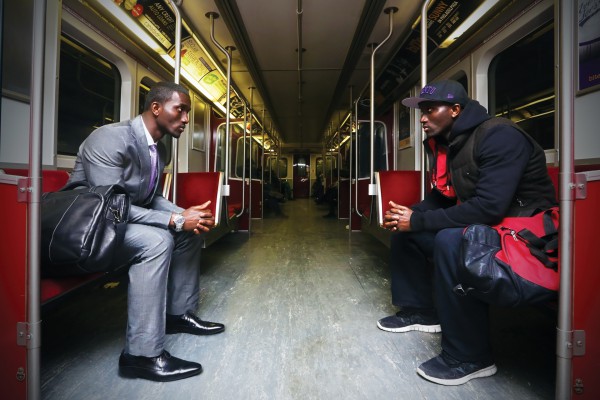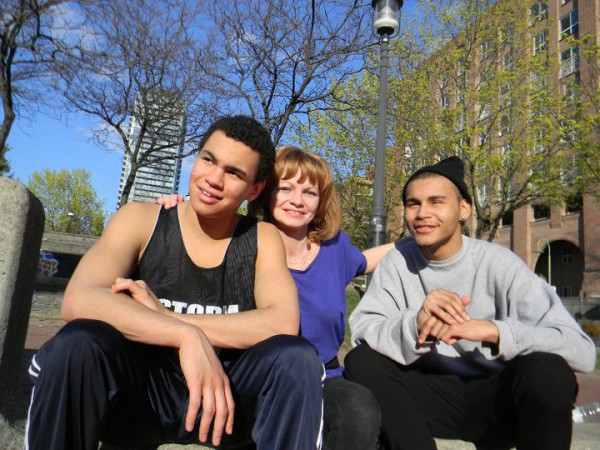GBC alumni and staff show that no matter where you come from, you can always find success

“Those drug dealers that were on the corner selling drugs, they were the same ones telling us to stay in school because they didn’t want us to be like them,” said Francis Atta, GBC alumni. Photo courtesy of Francis Atta.
“Those drug dealers that were on the corner selling drugs, they were the same ones telling us to stay in school because they didn’t want us to be like them,” said Francis Atta, George Brown College (GBC) alumni. “It was those drug dealers that treated us like brothers and sisters. So as bad as they were, they were also positive.”
Toronto is home to many youth that are considered to be at-risk. They are typically defined as young people between the ages of 14 to 29 from priority neighbourhoods, many of whom have been exposed to violence and homelessness.
Growing up in the Jane and Finch area, one of the city’s roughest neighbourhoods, childhood wasn’t easy for Atta.
Watching his father take care of a big family as a single parent and going to work every day in a factory, Atta remembers the difficulties faced at home.
He was was struggling to stay motivated and neglecting his education and associating himself with gangs, but eventually he became determined to make a positive change in his life.
“The individuals are all different. They run the gauntlet of poverty, having overcome the odds to simply being in school. It’s an achievement in itself,” said Dr. Vidoll Regisford, vice-president of missions services and human resources at Goodwill. “This is in spite of the day to day challenges of residing in Toronto and some of its toughest neighbourhoods, where high unemployment rates are the norm, and a lack of community resources and supports limits access to essential services, poor housing and the overwhelming sense of hopelessness.”
With 30 years of experience working with at-risk youth, Regisford has expertise in many areas including diversity and inclusion, education (primary, high school, universities and colleges), multiculturalism and why diversity in leadership is important.
Atta watched his friends drop out of school and become involved with the wrong people, and emphasizes how important it was for him to have a role model, and how the encouragement and support that comes from a role model can make all the difference in a youth’s life.
However, he is unable to speak for everyone. As he says, “I know most of the guys that are in gangs, its sad to say, sometimes it’s for attention at home, sometimes I feel that they are probably depressed because they’re not doing well in school.”
Regisford, who grew up in the same neighbourhood, says, “there is still a deeper, visceral, and emotional response when it comes to asking for help. This can include, but is not limited to the fear of negative judgments by others and being perceived as weak or ill-equipped for post-secondary education.”
Atta believes that education systems need to do something to help these kids who are feeling like their lives are over because they can’t understand academics or because they don’t fit in with the people who are doing well.
When he decided to go back to school at 22 years old, it was a big step for him. At the time he says, “I was actually homeless, living on the streets. My dad’s house that we had, we all had to move out of and I didn’t want to move in with my mom and step dad because there was too many kids.”
He was at a friend’s house for a bit and was kicked out of there, and ended up going to a shelter.
Seeking assistance through OSAP (Ontario Student Assistance Program), he was able to pay rent and go to school, and applied for many scholarships on top of having financial aid.
He won several of the scholarships he applied for through GBC. He also won the Garfield Weston Scholarship, which was designed to recognize students who show strong commitment to their programs and that are interested in making positive contributions to their communities, according to the award’s website.
Using this scholarship, he paid for the child and youth worker program that he graduated from in 2012.
The barriers that young people face to succeed are complex, real and diverse. They include but are not limited to: domestic abuse, health and mental health, financial and employment problems, as well as the neighbourhoods where they live.
For Deborah Crane, GBC alumna and facilities support staff for the Student Association (SA), losing youth in her community—the Esplanade near St. James campus, and watching her son struggle with the law was reason enough to go back to school and get involved in her community.
“One thing I have learned is that there is no stronger energy than the energy you gain from your children. The more my son was getting into trouble, the more determined I became,” wrote Crane in an email.
She had been receiving phone calls in the middle of the night saying her son had been arrested. He had been associating with gangs and getting into serious fights. It was then that she knew it was time to step up and show him there was a better way.
Understanding that she couldn’t change the past, she knew she could change the future. After looking into programs at George Brown and applying for second career funding, she was aware of the many more challenges to come.

Deborah Crane, centre, sits with her son Kurtis Crane (left) and nephew Dexter Stewart (right) at the basketball court they helped renovate as part of the Esplanade Youth Movement. Photo courtesy of Deborah Crane.
Through excitement, frustration and tears, Crane stuck with it. She went to appointments and filed lots of paper work, and through all that she says something she didn’t realize “was that my son was watching me. He saw me not give up.”
When her son decided to leave the city to disassociate himself from certain people, it gave her the overwhelming motivation to continue to help the youth in her community and to try and make a difference.
“I’ve seen this in action when I learned about Deborah by a family who had worked with her,” said Amane Samir, a marketing student at GBC. “She’s genuine about what she does. She helps address issues, and awareness over all needs to be raised.”
After talking to community members, parents, and the youth group she was already involved with, Crane did whatever she could to show these kids that they didn’t need to resort to fighting, guns, or violence, and eventually developed a youth group in the community called The Esplanade Youth Movement.
The youth movement works closely with the Metro Toronto Police—51 divison and the Community Police Liason Committee, and together they hope to build better relationships between youth and the police, holding an event and a basketball tournament every summer in their community.
Through her involvement with the community, she has also connected some of the youth to programs at the college.
“I’ve been labelled as at-risk before. I come from the west end. It destroys the self-esteem and it damages the spirit,” said Fahima Ali, a marketing student at GBC. “I really enjoy being at school, the atmosphere, the professors, and my friends. It’s all been great and I’m in my first year.”
When facing uncertainty, Ali says the best thing someone can do is to find someone to trust.”If you grow up labelled, the trust won’t be there,” said Melanie McIntosh, the SA’s hospitality representative. “Deborah helps us build on trust we need. We think of her as our Mom. People need to be able to be themselves.”
Crane is dedicated to supporting the youth in her community and showing them a better way of living, much like Atta who is motivating and inspiring others through his organization K.E.Y.S. (Knowledge & Effort Yields Success).
“It doesn’t matter how low you are, if you really want to change your life, if you want to go to school—you can go to school,” said Atta. “School is for everybody. It’s not easy but if you work hard and if you make sacrifices, you will get what you want. You have to go to school, education is really important.”
At George Brown, youth are also able to attend a program called CHOICES, “dedicated to supporting growth and restoring hope in the lives of at-risk youth.”
Based on the philosophy that all youth have a right to safe living environments, the CHOICES program provides protection and a positive well-being and support services, according to their website.
“What people really get out of this, from what I’ve seen, is a renewed outlook of themselves,” said Ambrose Kirby, co-ordinator for CHOICES. “We give them an honest picture here and we also help refer them to where they need to be, not just George Brown but also universities, other colleges and apprenticeships. They can also explore their personal career options. We get all kinds of people and help them look past barriers.”
Open to anyone who is 19 years or older, the program offers a series of workshops that take place over a week, with classes that are offered twice a month at the St. James campus.
Through CHOICES, youth are able to get the information they need, meet with alumni, get a college experience and connect with resources like OSAP and the career centre, helping to make tough, life-changing decisions a little easier.

